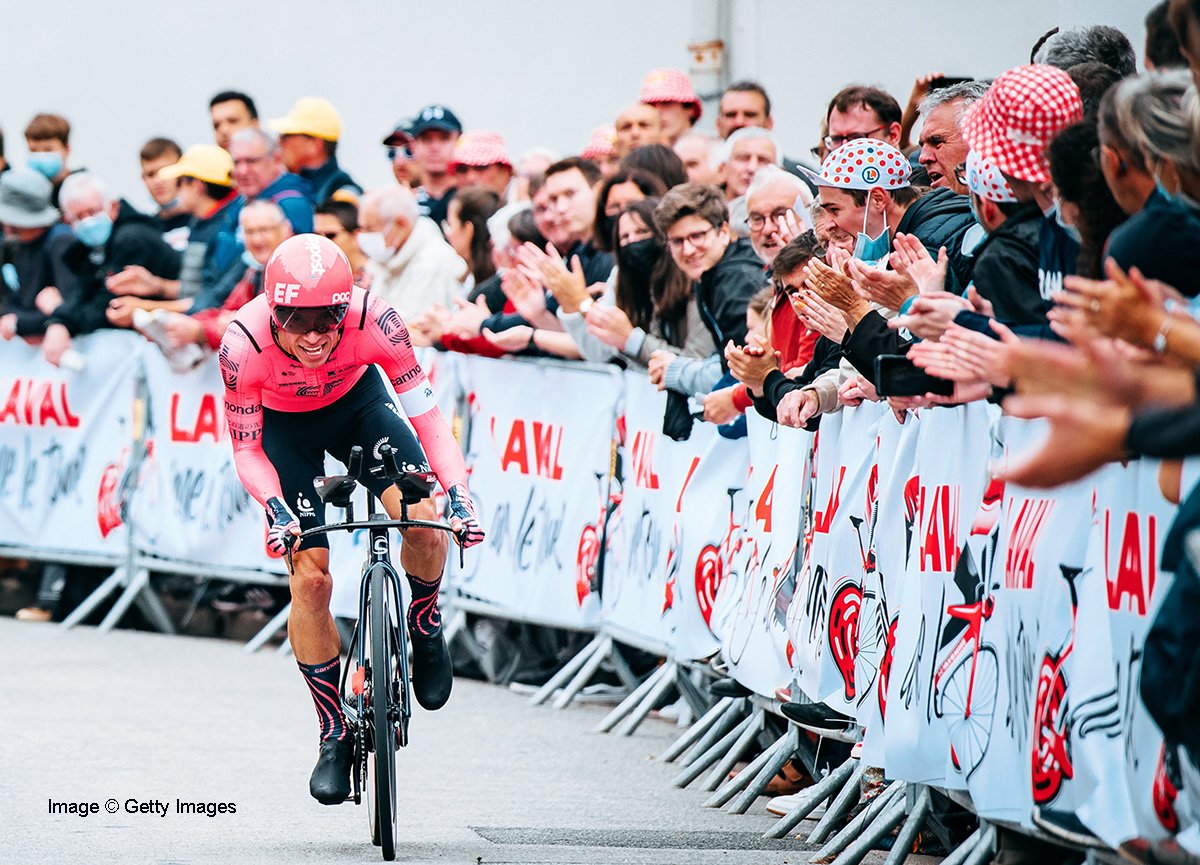A Day at the Time Trial During the Tour de France

July 15, 2021
Grand Tours consist of multiple disciplines where General Classification (GC) contenders can rely on the help of their teammates — except for the time trials. In this individual short race, it’s every man for himself. Here you can make up or lose a lot of time. One little mistake or bad form can ruin a good spot in the GC rankings, as we saw last year in the decisive time trial in the Tour de France. Will it happen again this year? Rigoberto Urán of EF Pro Cycling knows all about it and talks us through a typical day at the office during a time trial.
Urán is one of the top contenders when it comes to a high GC ranking in the Tour de France. He became second overall in 2017, seventh in 2019 and eighth in 2020. “For me, the Tour is special and the most important race in the world with the best riders. It is very hard, and I always do my best to finish as high as possible. But there are many factors that come into play: your health, a good condition for the 21 stages, staying out of accidents, crashes, mechanical failures and so on. But I must admit: Once you’ve been on that final podium in Paris like I did four years ago, you want to achieve that again!”
While the Colombian star is known for his great climbing skills, he’s a fast time trialist as well. Urán especially likes the time trial (TT) in the Grand Tours, and we can see this in his results. In almost every TT in the Tour de France, he finished within the top 10. “I just love the time trials! I’m not a Cancellara, but I’m not bad for a climber,” he laughs. Urán trains about two times per week on his TT bike throughout the year but explains why you won’t find him in front of the results after the prologue or at a stand-alone time trial. “That’s totally different because then everybody is fresh at the start, or they have only prepared for this discipline. Look, I’m not a TT specialist, but in a Tour de France after 19 stages and climbing the mountains, your legs feel different, and you need more power. There lies my strength. I’ve got the good equipment for this year’s TT in the Tour, the bike is working well, and I trained for the TT. We’ll see,” said Urán, who surprised everyone at the Tour de Suisse by winning the time trial stage.
What does a time trial day look like?
Because a time trial starts later during the day than a normal stage in a Grand Tour, the riders have time for an extra training in the morning. This is when they check all the details of the course again with the team: the corners, where the wind is coming from, what kind of gear ratio they will use, etc. Sometimes they do a course recon a few months before the race, but the extra recon on the day itself is vital. “That’s very important, because then the course is closed and looks totally different. There is no traffic, and you have to cut the corners in a different angle because of the fences they’ve placed on the track.”
Nutrition is just as important during a TT as in a normal stage but for the chefs, it’s a day of hard work. Because every rider has a different start time, they can’t have breakfast together, and they all eat at a different time. Even though a TT race is much shorter than a normal stage in a Grand Tour, Urán eats the same. “Normally for a stage in the Tour, I eat 3 hours before the start. I eat an omelet with three or four eggs and cheese, some rice, bread, and drink coffee. And I don’t like to change my menu, so for a TT I also eat the same meal 3 hours before the race. If I start at 5 p.m., I have an early breakfast and then at 2 p.m. I eat my omelet, rice, etc.” Besides the chefs, the rest of the team, like the mechanics, also works all day long because of the individual start times. “It’s just a 1-hour race, but you need 10 hours to prepare everything.”
Warming up on the Tacx® trainer
When the hotel is close to the track, Urán normally leaves the hotel 2 to 3 hours before the start. One hour before his TT race, he starts warming up on the Tacx NEO 2T trainer. Those of you following Urán on social media must have seen that he loves to train on the Tacx trainer. Take, for example, last year when he was injured after a crash and during the lockdown when it was not possible to train outdoors. “I rode every day in the virtual worlds of Zwift. I really like it and use the Tacx often. Besides, you can optimize your pedal stroke on a TT bike with a Tacx trainer and test your perfect position. Only on a Tacx can you ride for 40 minutes without braking for traffic or corners and fully focus on these things.”
Before Urán starts the warming up, he makes sure everything is ready for the race: The radio is attached to his body, the communication is plugged into his ears, he’s got his TT suit on, the shoes, the gloves — everything. Only the helmet needs to be put on before the race. Some riders prefer to do the warming up on the road bike, but the Colombian uses his TT bike…
